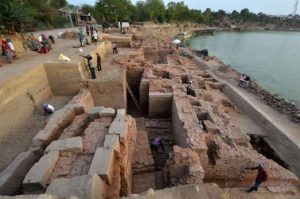Since the time of the historical Buddha, Boṅgabhūmi—which comprises modern-day Bangladesh and West Bengal, India—has been recognized as a significant region for Buddhism due to the early transmissions that took place there. Buddhist inscriptions appeared in the area shortly after the historical Buddha (563–483 BCE) visited this region. Boṅgabhūmi reached its Buddhist apex over a number of centuries: during the reign of Aśoka (304–232 BCE) of the Maurya Dynasty (322–184 BCE), the Gupta Dynasty (240–550 CE), and the Pāla Dynasty (750–1161 CE). From the Buddha’s time to the modern period, a large number of Buddhist monasteries were built and contributed to propagating Buddhist teachings throughout Boṅgabhūmi.
The Buddhist presence in modern-day Bangladesh rapidly declined after the 12th century. A few Buddhist monasteries continued to protect their traditions, despite much hardship and regression. Unainpūrā Laṅkārāma is one of those surviving monasteries that have helped to sustain the Buddhist presence in Boṅgabhūmi. Unainpūrā Laṅkārāma is one of these monasteries, located in the village of Unainpūra, in the sub-district of Patiya and district of Chattogram (also known as Chittagong) in Bangladesh.

Unainpūrā, a prominent spiritual village, was the birthplace of numerous Buddhist scholars, monks, and spiritual leaders who, over the past few centuries, have contributed to the spread of Theravāda Buddhism in Boṅgabhūmi and the Indian subcontinent. According to the local histories and a white stone rock edict, which records Unainpūrā Laṅkārāma’s history since the 1600s, there were 16 prominent monks who were born in Unainpūrā, and are listed below in chronological order:
1. Śrīmat Joydharā Mahāsthabir (1600–72)
2. Śrīmat Dhruba Mahāsthabir (1630–90)
3. Śrīmat Chad Mahāsthabir (1630–90)
4. Śrīmat Krēṁlahā Mahāsthabir (1700–80)
5. Śrīmat Thānā’i Mahāsthabir (1720–85)
6. Śrīmat Hrepasu’i Mahāsthabir (1725–90)
7. Śrīmat Mōhana Chandra Mahāsthabir (1730–80)
8. Śrīmat Mukulacāna Mahāsthabir (1730–95)
9. Śrīmat Sudhana Chandra Mahāsthabir (1735–1810)
10. Śrīmat Saṅgharāj Ācārya Pūrṇāchār Chandramōhan Mahāsthabir (1834–1907)
11. Śrīmat Jagaṯ Chandra Mahāsthabir (1852–1948)
12. Śrīmat Gaurachandra Mahāsthabir (1850–1910)
13. Śrīmat Kṛpāśaraṇa Mahāsthabir (1865–1926)
14. Śrīmat Saṅgharāj Dr. Dharmasen Mahāsthabir (1928–2020)
15. Śrīmat Bōdhipāla Bhikkhu (1968–2020)
16. Śrīmat Bōdhimitra Mahāsthabir (b. 1970)

Two monks closer to the modern period—Ācārya Pūrṇāchār Chandramōhan Mahāsthabir (1834–1907) and his disciple, Kṛpāśaraṇa Mahāsthabir (1865–1926)—can be confirmed to have made significant contributions to the doctrinal and institutional reconstruction of Theravāda Buddhism in contemporary Boṅgabhūmi.
Ācārya Pūrṇāchār Chandramōhan Mahāsthabir (1834–1907), also known as the 2nd Supreme Patriarch (saṅgharāj) of Bangladesh, was one of the most prominent Theravāda teachers of Boṅgabhūmi and remains respected by devotees, seekers, and monastics throughout the world. One of the notable contributions of Chandramōhan Mahāsthabir was his initiative to reform Theravāda Buddhism.
With regard to the monastic codes (Vinaya) of the Theravāda order, Ven. Chandramōhan observed that local monks in Boṅgabhūmi were not only not following Buddhist law, but they also did not ordain properly. Understanding the value of refining monastic orders and the importance of having an effective leader, Ven. Chandramōhan requested an elder monk, Mahādham’mārājādhirāja Guru Sāramēdha Mahāthērō (1801–82), to return to Chattogram from Akyab (present-day Myanmar).

Supported by Sāramēdha Mahāthērō, Ven. Chandramōhan called for a monastic congregation in 1864 in the prominent village of Pahartali, located in Raozan, Chattogram. This congregation was one of the most significant events for Bangladeshi Buddhism, since at this conclave monks relearned the monastic codes of disciplines (Vinaya) of the Theravāda order. Following the noble instructions of Sāramēdha Mahāthērō, seven senior monastic members re-ordained and declared themselves members of the Theravāda order. In this historical gathering, those monks who agreed with the decision of Sāramēdha Mahāthērō considered the elderly monk as their supreme patriarch, or “Saṅgharāj.”
Ven. Sāramēdha Mahāthērō was the first Saṅgharāj (supreme patriarch) of modern Buddhism in Boṅgabhūmi, and founded the “Saṅgharāj Nikāya” in 1864. After the passing of Sāramēdha Mahāthērō, Ven. Chandramōhan, the former abbott of Unainpūrā Laṅkārāma, was appointed as Saṅgharāj in 1882. Since then, Ven. Chandramōhan graciously and enthusiastically led the monastic members of the Saṅgharāj Nikāya of Theravāda Buddhism until his death in 1907.

Inspired by Ācārya Pūrṇāchār Chandramōhan Mahāsthabir (1834–1907), his disciple, Kṛpāśaraṇa Mahāsthabir (1865–1926), made outstanding contributions to the spread of Buddhism, developing local philanthropy, extending humanitarian services, and education in undivided India and Boṅgabhūmi. During the British Raj, when Theravāda Buddhism was reforming in the Bengal Delta, Kṛpāśaraṇa Mahāthērō took on a significant role in spreading Buddhism by establishing a number of monasteries, Buddhist organizations, and educational institutions. In affiliation with Unainpūrā Laṅkārāma, Ven. Kṛpāśaraṇa founded the renowned Baud’dha Dharmāṅkūra Sabhā (Bengal Buddhist Association) in 1882 in Kolkata. Subsequently, it became one of the major Buddhist institutions of the Indian subcontinent and helped to spread Buddhist education and Theravāda Buddhism. Ven. Kṛpāśaraṇa also contributed to establishing a number of educational institutions, including the following schools:
1. Mahamuni Anglo-Pali Institution;
2. Silak Dowing Primary School;
3. Kartala-Belkaine Middle English School;
4. Noapara English High School;
5. Andharmanik High School;
6. Naikaine Purnachar Pali School;
7. Dhamakhali High School;
8. Pancharia Middle English School;
9. Satbaria Girl’s School and Library;
10. Unainpura Primary School;
11. Unainpura Junior High School;
12. Rangunia English High School;
13. M.A. Rahat Ali High School;
14. Sakhpura English School; and:
15. Rangamati School and Library.
Concerned with promoting Pāli and Sanskrit studies, Kṛpāśaraṇa reached out to Sir Ashutosh Mookerjee (1864–1924), the former vice-chancellor of the University of Calcutta. At the request of Kṛpāśaraṇa Mahāthērō, Sir Ashutosh Mookerjee approved the authorization for the Department of Pāli Studies to be formed at Kolkata University in 1907. Kolkata University was the first institution in South Asia to introduce a program in Pāli Studies.
Kṛpāśaraṇa Mahāsthabīra renovated and reconstructed Unainpūrā Laṅkārāma in 1921 and passed away in 1926 in Kolkata. His body was returned to the monastery in 1927, where his grand funeral ceremony was organized by a large number of devotees, monastic members, and followers.

With the support of the spiritual inspirations of Chandramōhan Mahāsthabir and Kṛpāśaraṇa Mahāsthabir, Gyaniswer Mahāsthabir (20 December 1887–28 October 1974), a pioneering Theravāda teacher, began to reside at Unainpūrā Laṅkārāma in 1919. Once he started his spiritual career at Unainpūrā Laṅkārāma, Gyaniswer Mahāsthabir tirelessly taught the Dharma to monastics and lay devotees. He also tried to spread knowledge of the ancient Indic languages, such as Pāli and Sanskrit. For beginners of the Pāli language, Gyaniswer Mahāsthabir compiled his monumental text Pāli Prabēśa (Entrances to Study Pāli Language) in 1937. Pāli Prabēśa is still in use today as a textbook for Pāli Studies in Bangladeshi and Indian institutions, including Dhaka University, Chattogram College, Noapara Collge, and Chittagong University in Bangladesh, as well as Kolkata University of India.
Throughout his life, Gyaniswer Mahāsthabir taught insight meditation (vipassana) and trained monastic members and lay devotees. It is worth mentioning that Gyaniswer Mahāsthabir’s two monastic disciples became supreme patriarchs in two separate countries. Dr. Dharmasen Mahāthērō (1928–2020) was the 12th saṅgharāj of Bangladesh, whereas Dharmapāl Mahāthērō became the saṅganāyaka of India.
Moreover, Ven. Gyaniswer’s student, Sīlānanda Brahmacārī (1907–2002), became a pioneering scholar in postcolonial India. Sīlānanda Brahmacārī translated numerous Pāli texts into Bengali and a number of other books into both Bengali and English. Apart from teaching insight meditation (vipassana), Gyaniswer Mahāsthabir re-introduced traditional Buddhist events to the community, such as Buddha Puja; the robe-offering ceremony (katīna cībar dāna), and Madhū Pūrnīma in modern Boṅgabhūmi.
Gyaniswer Mahāsthabir passed away on October 28, 1974, at the age of 87. His legacy deeply impacted the propagation and preservation of Theravāda Buddhism throughout Boṅgabhūmi and the Buddhist world.


After the death of Gyaniswer Mahāsthabir in 1974, his disciple, Saṅgharāj Dr. Dharmasen Mahāthērō (1928–2020) became the abbot of Unainpūrā Laṅkārāma. Saṅgharāj Dr. Dharmasen Mahāthērō, the 12th supreme patriarch (Saṅgharāj) of Bangladesh is one of the most prominent Theravāda teachers of Boṅgabhūmi. He is respected by devotees, followers, seekers, and monastics throughout the world. Ven. Dharmasen’s Dharma talks inspired the villagers of Unainpūrā and the Buddhists of Boṅgabhūmi to remain steadfast in their faith.
The notable features of his teachings emphasized monastic discipline, the vitality of lay involvement, and the teachings’ use as a vehicle for Dharma practice in daily life. Ven. Dharmasen wrote numerous books and articles in the Bengali language. He was the author of monumental Buddhist works of literature, including Triratna Bandanā (1962); Vinaya Saṅgraha (1978); Baudhō Dharma Śikṣā (1981); and Tri-Mahājībana (1990). Under his spiritual leadership, Ven. Dharmasen established guidelines and codes of conduct, which created a sense of renewed purpose and unity for the monastic community.
To propagate the Dharma in Bangladesh, he fostered relationships with prominent Buddhist organizations, including the Bangladesh Saṅgharāj Bhikkhu Mahāsabha (the Supreme Saṅgha Council of Bangladesh) and Saṅgharāj Pūrṇāchār Bhikkhu Sangsadh (the Saṅgha Council of Saṅgharāj Pūrṇachār). Saṅgharāj Dr. Dharmasen Mahāthērō continued to offer Dharma scholarships to the devotees and followers of Boṅgabhūmi until his death on March 20, 2020.
After Dharmasen Mahāthērō’s passing, his disciple, Bōdhimitra Mahāsthabir (b. 1970), took up management of Unainpūrā Laṅkārāma for two years from 2020 to 2022. Ven. Ratana Nanda Bhikkhu was appointed as the newest abbot of Unainpūrā Laṅkārāma in 2023.


Unainpūrā Laṅkārāma is one of the few remaining ancient monasteries whose contributions and legacies have maintained Theravāda Buddhism in Boṅgabhūmi over the centuries. From Joydharā Mahāsthabir to Ven. Ratana Nanda Bhikkhu, the monastic members of Unainpūrā Laṅkārāma continue to support the Buddhist teachings. The villagers of Unainpūrā have, since records began, offered unwavering support for the four requisites—food, clothes, shelter, and medicines—of the monks of Unainpūrā Laṅkārāma. Unainpūrā Laṅkārāma is recognized as one of the pioneer institutions of Theravāda Buddhism in Boṅgabhūmi and protector of Bangladeshi Buddhist practice, manuscripts, and heritage.
References
Mahāsthabir, Dharmasen. 2009. “Kathāmṛita (Blissful Words),” In Mahājñānī Mahājana. Edited by Chandrajyoti Bhikkhu. Chattogram: Gandhara Art Press.
Mahāsthabir, Dharmasen. 2021.“Unainpūrā Laṅkārāma,” In Jyōtirmaẏa Dharmasen. Edited by Sajib Barua Diamond, Sanjoy Barua Chowdhury, et al., 436–37. Chattogram: Purba Publishing.
Mahāsthabir, Dharmādhār. 2009. “Bānlādēśe Sad’dharma Punarut’thānē Pradhāna Ācāryagana [The Contributions of Buddhist Monks for Revivaling Buddhism in Bangladesh],” in Buddhism in Bengal. Edited by Brahmanda Pratap Barua, 169–80. Kolkata: Barun Kundu.
Brahmacārī, Sīlānanda. 2009. “Mahayogi Gyaniswer,” in Mahājñānī Mahājana. Edited by Chandrajyoti Bhikkhu. Chattogram: Gandhara Art Press.
Chowdhury, Sanjoy Barua. 2022. Walking Into The Light of Dhamma. Songkhla: International Buddhist College, Thailand. Accessed 2 March 2023 at: http://ibc-elibrary.thanhsiang.org/node/981
Chowdhury, Sanjoy Barua. 2022. “A Forgotten Buddhist Philanthropist from Boṅgabhūmi: The Life and Works of Kṛpāśaraṇa Mahāthērō (1865–1927)”. In Studio Orientalia Slovaca. Vol. 21.2. 89-115.
Sunandapriya Bhikkhu. 2010. “Bāṅālir Paricchanna Dhārār Baud’dha” [The Pristine Heart of Bengali Buddhists], in Jagaṯjyōti. Edited by Hemendu Bikash Chowdhury. Kolkata: Dharmāṅkūra Baud’dha Sabhā.
Related features from BDG
Āryaśrābaka Gyaniswer Mahāsthabir (1887–1974): The Life and Legacy of a Seminal Bangladeshi Theravada Master
Karmayōgī Kṛpāśaraṇa Mahāthērō (1865–1927): The Forgotten Monk Who Built Buddhism in Modern India and Bangladesh
The History and Heritage of the Buddhist Diffusion in Boṅgabhūmi











